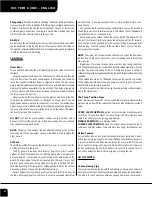
9
Fuelling Procedures
Internal Built-In Fuel Tank
If fuelling the boat whilst in the water, be sure it is securely
moored to the wharf. Turn off all electrical equipment including
the engine, appliances, bilge blower, lights etc. Exnguish all
cigare'es, cigars or other items that may produce a spark or
flame.
Through-deck fi9ngs are provided for fuel tank filling. Remove
the cap and insert the fuel supply nozzle, allowing the nozzle to
maintain contact with the fi9ng; this will prevent possible stac
sparking. If, when filling the tank, you can’t put fuel in at a
reasonable rate, pull the nozzle back slightly allowing air
circulaon between the nozzle shroud and the tank filler, this
will allow the tank breather to breath. Check the fuel vent line
to see that it’s not kinked or blocked. If the problem persists
consult your dealer. When you have finished fuelling, replace
the fill cap and wash off any fuel spillage.
Fuel up on your way to the water, not on your way home or
before you store your boat. Allow for thermal expansion of the
fuel on very hot days. Do not over fill the fuel tank.
Our boats have many different fuel tanks to suit our broad
range. Some tanks are deeper than others. Depending on the
fuel tank depth and the length of the fuel sender, the gauge may
not give a true indicaon of the amount of fuel remaining in the
tank when the gauge reads ‘empty’.
Never assume there is enough reserve in the tank to get home
as the fuel gauge may read differently while at sea due to
a9tude, lean or list of the boat.
Portable Fuel Tank
Remove the tank from the boat for filling. If your outboard
requires a petrol/oil mix, follow the engine manual instrucons
for the proper lubricaon oil and petrol rao mix. Before placing
the tank back in the boat, wash off any spilled fuel. Some
portable tanks have vent screws which must be open during
engine operaon.
Engine Use
The engine operang and maintenance manual provided with
your boat describes pre-start and starng procedures. Modern
engines are designed to be started in a parcular way. Read the
starng procedure for your engine carefully prior to a'empng
operaon.
Special Note
: The following advantages and disadvantages of a
Lanyard Stop Switch should be considered before elecng to use
such a switch.
Advantages
The purpose of a Lanyard Stop Switch is to stop the engine when
the operator leaves the control staon, either accidentally by
falling in the boat or by being ejected overboard. This is most
likely in certain types of boats such as low sided models or high
performance boats and as a result of poor operang pracces
such as si9ng on the back of the seat or standing at planing
speeds, operang at high speeds in shallow or obstacle infested
waters, drinking and driving, or daring high speed boat
manoeuvres.
Disadvantages
Inadvertent acvaon of the switch is also a possibility. This
could cause any or all of the following potenally hazardous
situaons:
1. Loss of balance and falling forward of unstable boat
passengers – parcularly in low bow rider style boats.
2. Loss of power and direconal control in heavy seas, strong
current or high winds.
3. Loss of control when docking.
Engine Star ng
Always ensure there is adequate venlaon with fresh air prior
to starng the engine to minimize the risk of fire or explosion.
WARNING
Spilt fuel may damage the hull and the carpet on your vessel.
If a fuel spill occurs insure it is cleaned up immediately.
WARNING
Do not use fuels that incorporate any form of alcohol or alco-
hol derivaves or ethanol. Alcohol and ethanol’s may destroy
marine fuel system hoses and components, which could lead
to hazardous leaks, fire or explosion.
WARNING
As we cannot possibly know of and advise the boang public
of all conceivable boat/power package types and/or poor
operang pracces, the final decision of whether or not to
use a Lanyard Stop Switch rests with you, the owner/ driver.
It is recommended that the lanyard be a&ached to the driver/
operator whenever the engine is in operaon.
Summary of Contents for boat
Page 1: ...OWNERS MANUAL ...
Page 19: ...19 ...








































